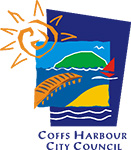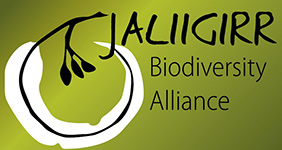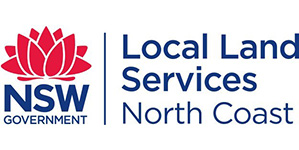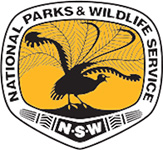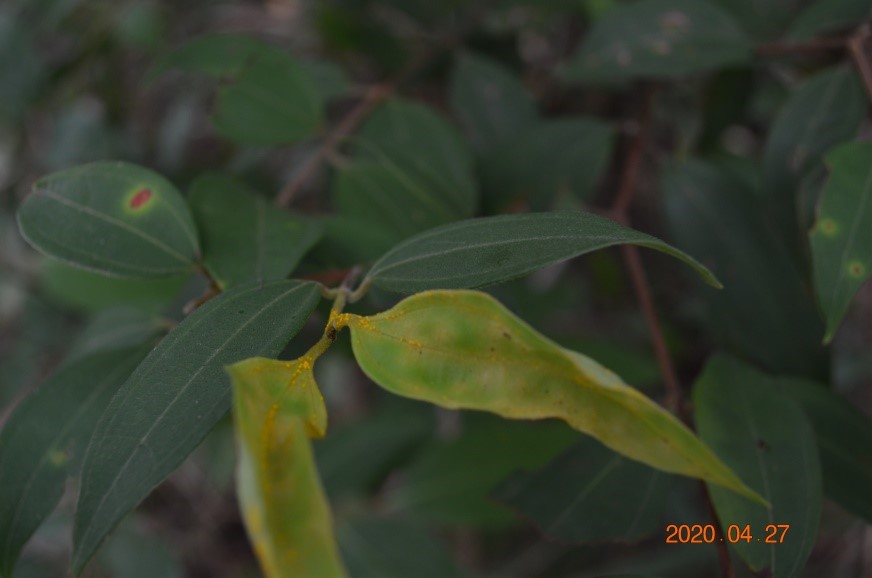
by Dave Wood (Landcare Volunteer)
Do you have listed endangered plants on your Landcare site?
While it is very easy to be focused on eradicating the ‘baddies’ during a typical Landcare session, it is possible that you may have a threatened species lurking close by, or even underfoot!
With the excellent rain events during mid and late summer we have seen an emergence of many new healthy plant seedlings which you may not have seen previously on your patch.
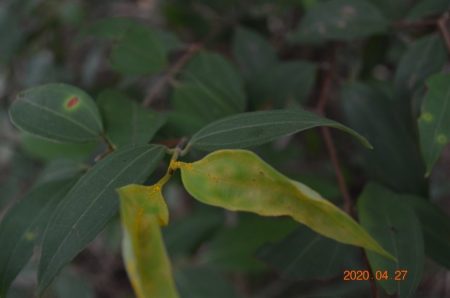
“Typical yellow myrtle rust spores on new leaf shoots and the 3 veined opposite leaf of R. rubescens. (Do not confuse with introduced tibouchina which has a very fine hairy cover and fine-toothed leaf margin.)”
A couple of critically endangered species which we have encountered recently are Scrub turpentine (Rhodamnia rubescens) and Native guava (Rhodomyrtus psidiodes). Both species have been almost totally wiped out in the wild since the myrtle rust (Puccinia psidii) appeared in NSW in 2010, with entire colonies well gone in some cases in as little as 3 years. For this reason, they were listed as Critically Endangered E4 category plants in NSW in 2018.
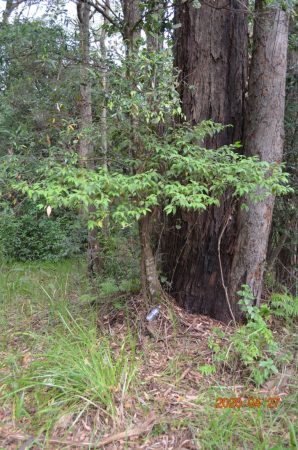
“Small scrub turpentine (Rhodamnia rubescens) alongside a large blackbutt.”
It seems the specimens we have found are mostly root suckers from original stock and while some are severely compromised, others appear very healthy and some of the guava even had fruit.
With the help of local botanist Craig Stehn from DPIE, we have provided plant material and seed samples for the research work being carried out by the Mt Annan Botanical Gardens Research Centre out of Sydney.
Identification of these and other species in the wild is all about being shown the plant in its typical habitat and getting your ‘eye in’. The rest is just vigilance, research, and patience …. and of course, a fair bit of luck. The scrub turpentine is typically found in the semi open under the canopy in wet sclerophyll … in our case under larger turpentine (Syncarpia glomulifera) and blackbutt (E. pilularis).
The native guava seems to like the open edges of littoral rainforest so keep an eye out along estuarine creek lines and behind dunal areas. Our Marian Grove specimen however was found in open wet sclerophyll forest.
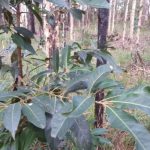 “Opposite leaf and branchlet of R. psidiodes” |
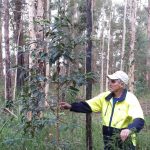 “Frank Kennedy checks out the Native Guava found on the Marian Grove Landcare site.” |
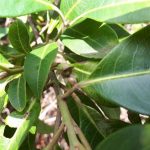 “A rare find – R. psidiodes with fruit found behind the dunes on the Murrays Beach Landcare site.” |
Other endangered plants in our region which you may wish to research and look out for include –
- Milky Silkpod (Parsonsia dorrigoensis)
- Moonee Quassia or Samadera (Quassia sp. Mooney Creek)
- Rusty Plum (Niemeyera whitei)
- Slender Marsdenia (Marsdenia longiloba)
- Slender Screw Fern (Lindsaea incisa)
- Stinky Lily (Typhonium sp. aff. brownii)
- Cryptic Forest Twiner (Tylophora woollsii)
- Dwarf Heath Casuarina (Allocasuarina defungens)
- Squarestemmed Spikerush (Eleocharis tetraquetra)
- Coast Headland Pea (Pultenaea maritima)
- Silverbush (Sophora tomentosa) – now coming back locally and quite common along the frontal dunes.
- Stinking Cryptocarya (Cryptocarya foetida)
- Southern Swamp Orchid (^Phaius australis)
- Floyd’s Grass (Alexfloydia repens)
- Hairy Jointgrass (Arthraxon hispidus)
- Scented Acronychia (Acronychia littoralis)
- Headland Zieria (Zieria prostrata) I believe this is present at Emerald ‘Look at Me Now’ headland.
- Austral Toadflax (Thesium austral)
If you are online, Google images is a good place to start, although the Atlas of Living Australia website also enables you to explore old records which can give you an idea of whether previous sightings have occurred in your area. While it may not have the official ‘clout’ of BioNET, you may find it easier to use and you can also register to upload your own sightings easier. The GPS co-ordinates which are given for sightings can then be used to do an on-ground search. I have a free app on my smartphone which gets me pretty close. To get your sightings onto BioNET you will have to be a registered and licensed user or contact one, to verify and upload your find for you. DPIE is a point of contact for that.
Some good photos uploaded to the NSW Native Plant Identification Facebook group (apply for membership) is also a great way to i.d. unknown species. They do also handle weeds and exotics so don’t feel too bad if you post a non-native.
Being able to identify and take precautions not to spread myrtle rust is also a significant issue for all Landcarers. I have added some weblinks to help in this regard. While the rust spores are readily spread by wind and animals they can be easily transferred on clothing and equipment. This is also true for a number of environmental pathogens so keeping our equipment, and footwear in particular, clean before moving between areas is an important work habit to take on board.
We wish to thank local ecologist Pete Richards and long-time bush regenerator Charlie England for their assistance in finding and identifying plants, as well as Craig Stehn from DPIE for his advice.
Weblinks:
https://www.facebook.com/groups/332752936930981/
https://www.dpi.nsw.gov.au/biosecurity/plant/insect-pests-and-plant-diseases/myrtle-rust
https://www.anbg.gov.au/chabg/myrtle-rust/powerpoint/Carnegie-myrtle-rust-anbg-2011.pdf
